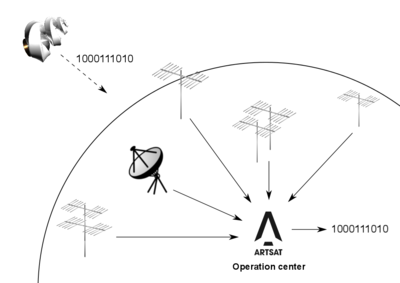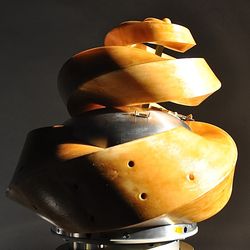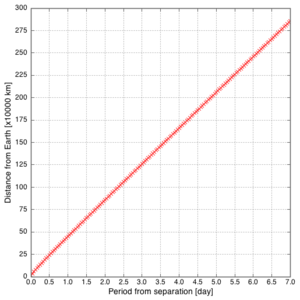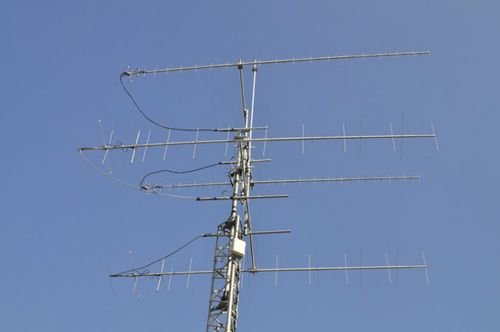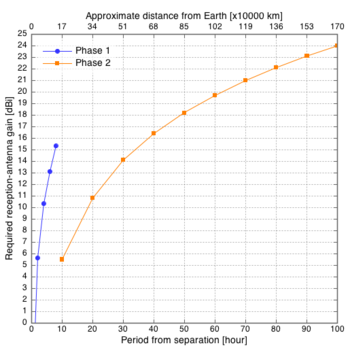Cooperative Data Reconstruction
As a main mission of DESPATCH, we are conducting an experiment in cooperative diversity communication. In the experiment, we attempt to collect signals from the spacecraft received not only at our own radio station in Tokyo, but at many ham radio stations around the world to reconstruct them back into the original data from the spacecraft. In this page, the details of the experiment and how to join it are explained.
Reception of such weak signals to reconstruct data from the spacecraft will require the expertise of exceptionally skilled ham operators. We are hereby providing a rare opportunity to receive radio signals transmitted by a spacecraft in deep space, and ask for your cooperation in this project.
DESPATCH design, subsystems, and trajectory are detailed in the Main Page.
Mission Overview
"ARTSAT2: DESPATCH" is the second mission of the ARTSAT project. This spacecraft, 50x50x45 cm in size with a mass of 32 kg has a helix-shaped segment making it a beautiful sculpture. DESPATCH will be launched into an Earth escape trajectory at November 30, 2014 13:24:48, JST (UTC+9) and moves away from Earth soon after launch. The simulation shows that it reaches lunar distance (385,000 km) from Earth within 24 hours of separation from the launcher.
The spacecraft, carrying a CW beacon in the 435 MHz band, will transmit the "generative poetry" created in deep space for only a week until it reaches a distance of 2.5 million km from Earth. However, the signals from DESPATCH are very weak and will be fading, because the spacecraft has no attitude control system and uses only a low-directivity antenna.
The ARTSAT project asks that you attempt reception of these very weak signals at your radio stations. As a main mission of DESPATCH, we are conducting an experiment in cooperative diversity communication. In the experiment, we hope to collect signals from the spacecraft received not only at our own radio station in Tokyo, but at many ham radio stations around the world. The design is to have transmissions decoded by volunteer ham-radio operators throughout the world forwarded to our data server via the Internet for reconstruction back into the original poetry from the spacecraft. With this experiment, we would like to verify the practical effectiveness of cooperative diversity communication.
Mission Planning
DESPATCH is going to be launched at November 30, 2014 13:24:48, JST (UTC+9) along with the Hayabusa-2 asteroid probe, and injected into an earth escape trajectory about 2 hours later.
The spacecraft, carrying a CW beacon in the 435 MHz band, will transmit the signals for only a week until it reaches a distance of 2.5 million km from Earth. We are hoping to receive three types of data — the generative poetry, housekeeping data, and a simple beacon. Accordingly, we have divided the 1 week mission period into three phases based on the spacecraft’s distance from Earth, as shown in the table below. In each of these phases, a different type of data will be transmitted by the spacecraft.
| Phase | Distance from Earth | Type of data received on Earth |
|---|---|---|
| Phase1 | ~ 170,000 km | Housekeeping data in Morse code |
| Phase2 | 170,000 ~ 1,600,000 km | Generative poetry in Baudot code |
| Phase3 | 1,600,000 km ~ | Spacecraft temperature in a simple beacon |
The phase changes are shown in the figure below — the colors representing each phase. The visibility times in five cities — Tokyo, Sydney, Berlin, Boston, and Buenos Aires — are shown in the figure as black bars. Please note that the times in the figure are expressed in Coordinated Universal Time (UTC).
We conduct the experiment for the cooperative diversity communication only in the phase 2, but we also appreciate your helps and reception reports in phase 1 or phase 3. The phase 2 runs for almost 100 hours as shown in the figure.
Telemetry Format
All of the signals from DESPATCH are transmitted by a CW transmitter in the 430MHz band. The signals with 7W power are radiated from a monopole antenna.
As mentioned above, the mission period is divided into 3 phases and different kind of data are received in each phase on Earth. Herein, the format of the data in each phase is explained.
Housekeeping Data(Morse)
In Phase 1, housekeeping data encoded in Morse, whose speed is 6 WPM, is received on Earth. This data is used to monitor the health of the spacecraft mainly at our own station in Tokyo. For this reason, this phase ends at the middle of the first visibility period in Tokyo. This signal carrying housekeeping data, repeats 4 sentences named AS0, AS1, AS2, and AS4. There are 10 second intervals, in which the transmission is off, between the sentences. The data format of the housekeeping data is described in the file below.
Generative Poetry(Baudot code)
Phase 2 is where we conduct our experiment on cooperative diversity communication. In this phase, Baudot-encoded generative poetry will be transmitted for reception around the world. Reception will be limited to noisy and intermittent signals given the considerable distance between the spacecraft and Earth. We expect it will be difficult (in some cases, impossible) for any lone ham operator to decode and interpret the signals.
As such, we are attempting to gather all bit strings, received and decoded by ham operators around the world through the Internet so the bit strings can be patched together to reconstruct the original poetry. The figure below shows the reconstruction process. In the figure, the word “DESPATCH” is reconstructed from data acquired by five ham operators. Note that the red letters are those that were rejected by majority vote.
Format of generative poetry
The signal, carrying the generative poetry, repeats 8 units named CP0, CP1, ..., CP7. Every unit has a header in 5 bits, a footer in 5 bits, and 40 bits between them, and they are encoded in the Baudot code. Since the Baudot code represents a character in 5 bits, every unit has the header in 1 character, the footer in 1 character, and 8 characters between them, in the Baudot code. But only the 40 bits in CP0, a blue part shown in the figure below, is not encoded and carries raw bits of some sensor readings.
4 units, CP2, CP3, CP4, and CP5, shown as red parts in the figure above, carrie the generative poetry.
CP2 and CP3 carry temperatures of the spacecraft represented in the "color-code." This color-code represents the color in 4 characters, e.g., the white is represented as "WHIT." The higher the temperature is, the brighter color is received on Earth, as if we saw the spacecraft through a thermal imaging camera. The rule to convert the color-code to the temperature is described in the xls file below.
CP4 and CP5 carry the consumption current and 3-axis angular velocities represented in the "rhythm phrase." This rhythm-phrase is a goup of phrases picked up from "Gadji beri bimba," a poem writted by Hugo Ball, and it is used in a song, "I Zimbra." That is, this rhythm-phrase plays a kind of the acoustic poetry generated from sensor readings. The rule to convert the rhythm-phrase to the current or the angular velocity is described in the xls file below.
Signal speed and encoding
The speed of the signal carrying the poetry is 1 bps. Since the size of every unit (CP0, CP1, ..., and CP7) is 50 bits, it takes 50 seconds to transmit each of units. Because there are 10 second intervals between them, it takes (8×(10+50) sec. =)8 min. to transmit from CP0 through CP7.
Please note that the Manchester code is used for encoding. Although the signal speed is 1 bps, the on/off of the CW can switch every 0.5 second in the shortest since the Manchester code encodes each of the binary states "1" and "0" as a rising edge (CW off→on) and a falling edge (CW on→off). For example, the signal carrying CP0 is something like the "Received Signal" in the figure below.
The file below is MP3 sound data which is converted from the signal carrying CP0 (CW on: no sound, CW off: sound in 440Hz).
Spacecraft temperature (Simple beacon)
Phase 3 is the reception of a radio beacon whose period cycle is 3 seconds and duty-ratio changes depending on temperature of the spacecraft batteries (T = 0x00~0xFF), as shown in the figure below. Spacecraft temperatures can be derived by simply detecting periodic changes in the faint signal.
Reception Report
As mentioned above, the mission period is divided into 3 phases. Herein, how to report the data you received in each phase is explained. Reception report is received at the web page below in every phase.
Housekeeping data
Please enter the strings decoded from the morse signal in the "Comment" form. Or, please upload the text file in which you entered the decoded strings.
Generative poetry
In the experiment on the cooperative diversity communication approach, we are attempting to gather all bit strings, received and decoded by ham operators around the world, and synchronize them for reconstruction back into the original poetry from the spacecraft. For this reason, we are asking every operator to send us not only the decoded bit strings but timestamps, which will tell us when each bit was received.
There are 3 types of methods to report the poetry with the timestamp.
1. Use the special forms
You can use the special forms, "Received Data and Frequency with Time stamp," in the reception report page to report the data (bit strings) with timestamps.
For examples, if you began to receive the signal carrying CP0 shown in the "Received Signal" in the figure below at November 30, 2014, 20:00:33 JST (GMT+9:00), you should enter "11/30/2014 20:00:33 +0900" in the left form ("Date" form) and "1,1,1,1,1,0,1,0,1,1,1,0,1,1,1,1,1,0,1,1,1,0,1,1,1,1,1,1,1,1,1,0,0,0,1,0,1,1,0,0,0,1,1,0,0,0,0,0,0,0" in the right form ("Data" form). The center form ("Frequency" form) may be omitted although there are additional explanations about it below of this section.
To report using these forms, please note the following things:
- You should not report the CW state (on/off), but rather the bit strings decoded from CW state based on the Manchester encoding (NOT the "Received Signal", but rather the "Binary," in the figure below)
- The strings should be split by commas (",") at each character ("0" or "1")
- If you cannot decide "0" or "1," replace it with a hyphen ("-")
- The timestamp should be specified as a moment when the first bit was received
And, using the "Add a row" button, you can report multiple bit strings received at different moments at once.
2.テキストファイルをアップロードする
受信したデータを受信時刻と一緒にテキストファイルに記入して、受信報告ページからアップロードしていただいても構わない。 テキストファイルにデータを記入する際の注意点は上で述べたものと同じであるが、 受信時刻の時刻系にはUTCを使うものとし、そのフォーマットとしては Java の SimpleDateFormat にしたがって "yyyy.MM.dd hh:mm:ss" のように記入するものとする。 例えば、2014/11/30 11:00:33(UTC)から上図 "Received Signal" に示すような信号が捕捉された場合、テキストファイルに以下のように記入する。 なお、複数の受信時刻で報告を行う場合は、同じテキストファイル内に行を追加する。
2014.11.30 11:00:33, 1,1,1,1,1,0,1,0,1,1,1,0,1,1,1,1,1,0,1,1,1,0,1,1,1,1,1,1,1,1,1,0,0,0,1,0,1,1,0,0,0,1,1,0,0,0,0,0,0,0
3.音声ファイルをアップロードする
信号を録音したサウンドファイルを受信報告ページからアップロードする。 この場合、サウンドファイルの録音開始時刻(UTCで1秒の単位まで記入)を受信報告ページの "Comment" フォームに記載する。
アナログ温度情報
受信された信号のデューティー比、信号の強度などを受信報告ページの "Comment" フォームから報告する。
受信周波数
DESPATCHのサブミッションとして、受信周波数を利用した軌道決定を行う。 電波の受信周波数に生じるドップラー効果は宇宙機の位置と速度(すなわち軌道)によって変化するため、 逆にドップラー効果の程度から宇宙機の軌道をより正確なものに更新(軌道を決定)することが可能である。 なお軌道決定の手法としては、宇宙機の位置と速度の6自由度を状態量とした カルマンフィルタ を構成し、受信周波数を観測量として宇宙機の位置と速度を更新する。
このミッションのため、受信報告の際には受信周波数およびそのときの時刻を一緒に報告していただきたい。 受信報告のページに専用のフォーム("Received Data and Frequency with Time stamp")が用意されているので、 報告の際にはそこに記入をすればよいが、以下の点に注意していただきたい。
- 受信周波数は100Hzの桁まで記入する
- 受信時刻は(最低でも)1分の桁まで指定する
なお、右側の"Data"フォームを空欄として周波数だけを報告することも可能である
この軌道決定の結果は後述するトラッキングページに反映し、より正確な宇宙機のトラッキングに役立てたいと考えている。 シミュレーションによると、この軌道決定によって受信周波数の予測精度が大幅に改善することがわかっている(下図を参照)。 報告される受信周波数の数が多いほど、軌道決定の精度は高くなる傾向にある。
DESPATCHの電波を受信するには
必要な設備
まず、DESPATCHは430MHz帯のCWを送信するため、その電波を受信するためには430MHz帯CWモード対応の受信機が必要である。
次に、長期に渡って電波を受信するには、以下に示すようなアジマスおよびエレベーション方向に回転が可能なアンテナが必要である。 DESPATCHは地球から急激に遠ざかるため、ミッションの終盤まで電波を受信するためにはゲインの大きい受信アンテナを使用することが望ましい。 下図は、分離からの経過時間に対して、その時点で受信マージンがゼロとなるような受信ゲイン(必要ゲイン)をプロットしたものである。 この図から、自局のアンテナで電波を受信できる期間をおおよそ知ることができよう。
なお、DESPATCHの通信系の仕様および回線計算は、以下のページに記載されている。
最後に、フェーズ2の共同受信ミッションに参加するには、受信したデータを処理するPCとその時刻調整が必要である。 前述したように、共同受信ミッションにおいては、世界各地で受信されたデータをそれと一緒に報告された受信時刻を用いて統合し、一つの詩として復元する。 CWのON/OFFが0.5秒で切り替わることを考えると、この統合処理を正確に行うためには受信時刻の計測精度が0.5秒以上に保たれていることがのぞましい。 このような理由から、NTP(Network Time Protocol)ツールを設定するなどして、受信に使用するPCのシステム時間をあらかじめ正しく調整しておいてほしい。
アンテナのポインティング
DESPATCHは地球脱出軌道に投入されるため、地球周回軌道を表現するTLE(二行軌道要素)はトラッキングに使用できない。 そこで、以下のページからDESPATCHの軌道情報を配信する。
このページのフォームに観測地点の緯度と経度(ほとんどの場合で、海抜は0で問題ない)を入力すると、観測地点から宇宙機がみえる時間帯(可視時間/パス)がいくつかリストアップされる。 また、その中で最も近い可視時間に関しては、宇宙機の方角および受信周波数などの情報が1分刻みでテーブルに出力される。
DESPATCHの見かけの速度は、低軌道の衛星と比較して非常に遅いので、このテーブルをもとにアンテナを操作すれば十分な精度でトラッキングが行えると考えられる (受信設備にもよるが、操作の時間間隔は10分もあれば十分であろう)。
もしくは、ARTSAT APIを利用することで、自作のソフトウェアから上のページと同様の情報を取得することもできる。
受信機の調整
DESPATCHの送信機の周波数は437.325MHzであるが、ドップラー効果による周波数のズレが生じる。 DESPATCHの周波数の変化は、低軌道の衛星と比較して非常に緩やかである(この周波数の変化のほとんどは地球の自転によるものである)。 前述のトラッキングページを利用することによって、ドップラー効果を加味した受信周波数を調べることができる。 トラッキング中には適宜、このページを参考にして受信機のチューニングを行っていただきたい。
なお、ドップラー効果の程度は観測地の緯度によって異なる。 例えば、ARTSAプロジェクトの地上局(東京都、北緯35度)付近では、マイナス10kHzからマイナス5kHz 程度の範囲でドップラー効果が生じる(下図を参照)。
リンク
- 最新情報・受信状況の配信
- 受信状況の配信
連絡先
info@artsat.jp
